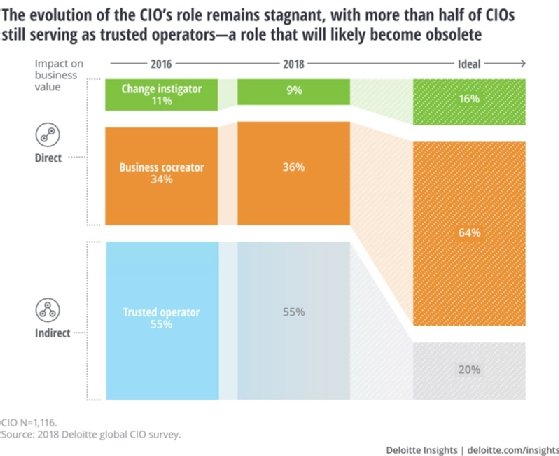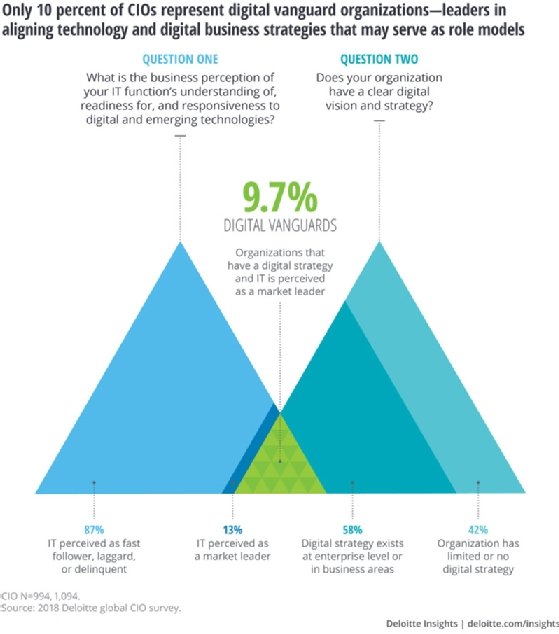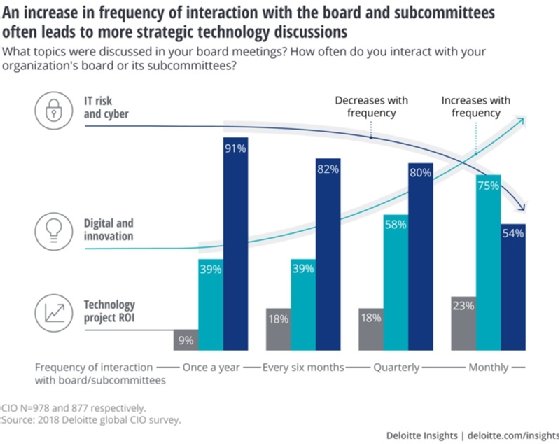
buchachon - Fotolia
IT leaders at a crossroads as they grapple with digital technology
CIOs have the opportunity to influence their company strategy as digital technology reshapes business. A survey of CIOs across 70 countries charts a path for IT leaders through emerging technologies
Most CIOs are still in roles that risk becoming obsolete as IT leaders struggle to make the jump from managing technology infrastructure to leading their company’s strategy for innovation.
CIOs have struggled to adapt their roles to meet the challenges of digital technology in their organisations, a major survey of 1,400 technology leaders across 70 countries has revealed.
Some 55% of CIOs are still focusing on the traditional CIO role of supplying cost-effective, reliable IT infrastructure, rather than working with the board to develop strategies for digital tech.
Less than 10% say they and their companies are advanced in their journey to incorporating technology into their digital business strategies, and more than half have not started.
Deloitte’s global CIO survey shows that many CIOs are at a crossroads, where they will need to choose between an increasingly functional role, or developing the skills to play a strategic role in their company’s board.
“CIOs have a heavy weight on their shoulders, but they can place themselves at the forefront of a company’s development, inspire change and support the executive in taking advantage of technology in order to transform their business,” said Mark Lillie, global CIO programme leader at Deloitte.
Deloitte has identified three types of CIO: the traditional CIO, known as the trusted operator, whose focus is to supply the cost-effective and reliable infrastructure the business needs; the change instigator, who takes the lead on business transformation and change initiatives in their organisation; and the business co-creator, who spends his or her time developing business strategy and uses technology to make sometimes dramatic business changes.
There has been little change in the proportion of each type of CIO over the past two years, despite predictions that the role of the “trusted operator” CIO will decline and eventually become obsolete.
The reason, Lillie told Computer Weekly, is that there is still a strong need for CIOs to ensure their organisations have a robust infrastructure in place, to support the digital technology they will need in the future.
Many organisations have yet to decide whether the CIO or someone with wider business experience should take responsibility for digital innovation, leading to further delays.
Over time, the number of trusted operator CIO roles will fall dramatically, as they are replaced by business co-creators and, to a lesser extent, CIOs performing the role of change instigator, says Deloitte.
“This is a critical moment for CIOs who are ready to step out of the shadows and join the ranks of executives strategising and executing the business’s next moves,” says the report. “The digital era has arrived at an opportune moment for CIOs looking to burnish their business credentials.”

What the top 10% of CIOs do differently
About 10% of CIOs stand out from the crowd in their ability to influence the company’s business strategy.
Dubbed “the digital vanguard”, they report that their organisations have a clear vision and strategy for digital technology.
Their IT organisation is perceived by the rest of the business as a market leader in digital and emerging technologies.
And their top business priorities are innovation, developing better customer experience, and growth.
There are huge opportunities for other CIOs , to follow the “digital vanguard”, with the majority of technology leaders predicting that CIOs, more than CEOs, will have one of the most important roles in driving digital initiatives over the next three years.

How CIOs can build up their influence
CIOs have reached their current positions more because of their technology knowhow than their vision, communication or relationships, but they recognise the need to develop business and softer inter-personal skills.
This will mean focusing on delivering major organisational change, building high-performance teams and developing the skills to influence others. These will be key priorities for CIOs.
A first step can be to help the rest of the business understand the impact of technology. Most CIOs have one-on-one discussions on the benefits of technology with their peers.
Advice for CIOs
- Don’t be afraid to step up in your changing role and drive forward your organisation’s digital strategy. You are well positioned to drive this.
- Build relationships with your business stakeholders.
- Position yourself in key business forums to understand your organisation’s strategy.
- Invest in your talent and build the right culture for them to explore and progress.
- Don’t be afraid to challenge the business where you think a solution is not viable.
- Operate at pace. Don’t be restricted by your organisation’s bureaucracy.
Source: Mark Lillie
But the most successful digital CIOs go further by organising enterprise briefings on technology and providing training on key technology topics to people outside the IT department.
The top 10% of digital CIOs – the digital vanguard – report stronger relationships with other business organisations than average. In particular, 65% report strong or very strong relationships with customer-facing parts of the business, compared with 50% of CIOs generally.
These strong links with managers in customer-focused areas of the business give them opportunities to initiate digital strategies, which can help CIOs evolve their role from building infrastructure to advising the business.
Finding a place on the board
Separate research shows that high-performing companies are twice as likely to have at least one technology-focused executive on the board, than are lower-performing companies.
By becoming a trusted adviser to executives on technology, and building up credibility with leaders in the business, CIOs are more likely to be invited onto the board.
Deloitte’s research shows that the more often that CIOs meet with board members, the more often the discussions are likely to turn to high-value topics, such as digital innovation and return on investment (ROI).
When CIOs meet with the board annually, their focus is largely on IT risk and cyber security. When they meet monthly, they are able to discuss digital technology and innovation 75% of the time, and are twice as likely to discuss the return on investment in technology projects.
Working more closely with business
When the IT department works more closely on this with businesses, they are more likely to share the same priorities, which leads to better business outcomes, according to the Deloitte research.
The importance of business and IT alignment has been well understood for decades, but Deloitte’s research shows that only 52% organisations outside the top 10% have a technology investment decision-making process that is jointly owned by IT and the business – and only 35% have a clear process for prioritising IT investments.
When it comes to measuring the return on digital investments, most IT departments struggle, with only one-fifth reporting that they have a structured process for measuring the value of technology investments in place.
What CIOS say
“Just about everything we do depends on technology. The organisation depends on us to help transform business models and change the way it does business” – Ralph Michaelis, CIO, Canadian Blood Services.
“It is critical for CIOs to ensure that IT strikes the right balance between driving future tech-enabled disruption and being too focused on day-to-day technology needs” – Eric Foster, CIO, Univar.
“The organisation expects us to be a business partner, not just evolve our IT operations” – Luis Carlos Maldaner, CIO, CBA (Aluminio).
“Digital transformation is less about a digital strategy and more about how to do business in a digital world” – Anne Mullins, CIO and corporate vice-president, Lockheed Martin.
“In order for IT to be invited to the table as a strategic partner, we have to build credibility by delivering a highly available and secure production platform and by delivering successfully on major change projects” – Rahul Samant, CIO, Delta Air Lines.
“Digital is transforming B2B industries such as ours to the point that our customers expect B2C experiences” – Joel Grade, EVP and CFO, Sysco Corporation.
“CEOs are looking to IT to enable growth through technology innovation. This means changing the business mindset that IT is an expense versus an investment” – Subhasis Mukherjee, VP and CIO, Perkin Insurance.
Source: Deloitte 2018 global CIO survey: Manifesting legacy: Looking beyond the digital era.
In the future, this may not matter so much. As organisations become more agile, measuring return on investment is becoming a less important metric, said Lillie.
“As organisations adopt agile ways of working, the appetite to complete onerous business cases to measure savings is diminishing and, instead, organisations are considering other aspects, such as customer satisfaction and speed to market rather than ROI,” he said.
One hurdle CIOs face is an annual budget cycle that leaves few resources for innovation. This is beginning to change as cheaper storage, cloud computing and outsourcing have driven down IT operating costs from more than 70% a few years ago to 56% now.
CIOs in the top 10% of digital organisations allocate less than half of their budget to IT operations, with the rest used for innovative projects and enhancing the business. They predict that operating costs will reduce to one-third of their IT budget over the next few years, freeing up more funds for innovation.

Combination of skills
In the future, according to Deloitte’s research, CIOs will need IT workforces with a combination of technological and interpersonal skills, which is different from today.
The technical skills that will be most in demand over the next three years will be analytics, data sciences, cyber security, and skills in emerging technologies and innovation.
But IT professionals will need more creative skills in the future to solve business problem in innovative ways and to engage users. They will need the ability to continually learn new technical skills, and the softer skills required to collaborate and influence people across other parts of the business.
“Smart CIOs are changing their organisation’s structure from a central and controlled hierarchy to build semi-autonomous product management teams,” said Lilley.
Many CIOs are responding by restructuring their workforce to provide the skills they need. Nearly 60% are bringing in skilled people from business partners, and a similar proportion are investing in retraining their existing staff.
Less than 40% are hiring and training graduates from university, with most preferring to hire experienced IT professionals from the jobs market.
The top 10% of companies at digital innovation are more confident of attracting the people they need by offering recruits the opportunity to work on new and emerging technologies. They believe their reputation as a digital innovator will enable them to attract and retain staff.
Some companies will need to change their cultures to attract top IT professionals in the future, and that needs to come from the top, said Lillie.
“Where CIOs want dynamic and entrepreneurial talent, they need to be encouraging and exhibiting these behaviours themselves,” he added.
Core IT technology
Investing in future technologies is impossible without a strong underlying IT infrastructure. Companies at the vanguard of digital technology now regard investment in security and privacy as strategic priorities, compared with many organisations that view them as an operational expense.
Many CIOs recognise that their existing IT systems lack the agility for innovation and scale, and are investing in enterprise resource planning (ERP) and other technologies. They expect investments in cloud technology to double from 22% to 44% over the next three years.
CIOs will need to balance investments between front-end and back-end IT systems to support digital innovation. Deloitte advises that investments in core technologies should not be viewed as standalone expenses, but as strategically integrated to digital technologies.
Emerging technologies
More than 40% of organisations expect emerging technologies – including artificial intelligence (AI), machine learning, the internet of things and robotic process automation – to have an impact on their organisations.
Few CIOs have a formal innovation programme to seek innovative technologies and to use them in a way that can produce real financial benefits for their organisations.
However, CIOs can develop innovation processes through a broader awareness of areas of innovation in other fields that could help their businesses, developing use cases and experimenting by rapidly introducing prototypes.









